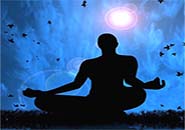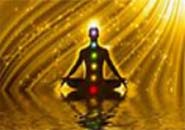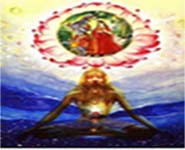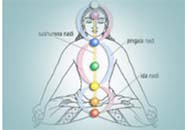Latest News
Types of Yoga
Hatha Yoga
 Hatha Yoga has been commonly used to describe the practice of asana (postures). The syllable 'ha' denotes the pranic (vital) force governing the physical body and 'tha' denotes the chitta (mental) force thus making Hatha Yoga a catalyst to an awakening of the two energies that govern our lives.
Hatha Yoga has been commonly used to describe the practice of asana (postures). The syllable 'ha' denotes the pranic (vital) force governing the physical body and 'tha' denotes the chitta (mental) force thus making Hatha Yoga a catalyst to an awakening of the two energies that govern our lives.
The Hatha Yoga system includes asana along with the six shatkarmas (physical and mental detox techniques), mudras and bandhas (psycho-physiological energy release techniques) and Pranayama (pranic awakening practices). Fine tuning of the human personality at increasingly subtle levels leads to higher states of awareness and meditation.
Ashtanga Yoga In Sanskrit "Ashta + anga" is Ashtanga. "Ashta" means Eight and "Anga" is limbs so it means Eight Limb path, ashtanga yoga is based on Yoga Philosophy of Patanjali. The asanas, Pranayamas or the dharana which we have studied earlier or the yam and niyam are based on the Yoga Sutras of Patanjali. Hence, we will acquaint ourselves with the fundamentals as stated by Patanjali first.
In Sanskrit "Ashta + anga" is Ashtanga. "Ashta" means Eight and "Anga" is limbs so it means Eight Limb path, ashtanga yoga is based on Yoga Philosophy of Patanjali. The asanas, Pranayamas or the dharana which we have studied earlier or the yam and niyam are based on the Yoga Sutras of Patanjali. Hence, we will acquaint ourselves with the fundamentals as stated by Patanjali first.
Eight Limbs of Ashtanga Yoga
1. Yama (Principles or moral code)
- Ahimsa - A principle of non-violence
- Satya - A principle of Truthfulness
- Asteya - A principle of non stealing
- Brahmacharya - Continence / Celibacy
- Aparigah - A principle of non-hoarding or non possessiveness
2. Niyama (Personal Disciplines)
- Shoucha - Purity
- Santosh - Contentment
- Tapa - Endurance
- Swadhyaya - Self study
- Eshwar Pranidhan Dedication
3. Asana (Yoga Positions or Yogic Postures)
- A stable and comfortable posture which helps attain mental equilibrium.
4. Pranayama (Yogic Breathing)
- Extension and control of breath.
5. Pratyahara (Withdrawal of Senses)
- A mental preparation to increase the power of mind.
6. Dharana (Concentration on Object)
- Concentration of mind on one object and its field.
7. Dhyan (Meditation)
- With drawing mind from all external objects and Focusing it on one point and meditating on it.
8. Samadhi (Salvation)
- State of Super bliss, joy and merging individual consciousness in to universal consciousness. Union between Jivatman and Paramatman. Union of Shiva and Shakti in Sahasrar Chakra (the top of the head). Realizing the Bramhan (pure consciousness) or Realization of God is the ultimate achievement of Human Birth.
Karma Yoga
 Karma Yoga is a path of devotion to the work. One looses his identity while working, only selfless work remains. This state is very difficult to achieve. Generally some rewards or incentives or outcome follows the work and one is attached to this reward or incentive. This is not the Karma Yoga. Non-attachment with the work and becoming the perfect instrument of the super consciousness in this manifested universe is the ultimate aim of Karma Yoga. In the initial stages of Karma Yoga, individual possesses strong sense of ego and consciously or unconsciously he is attached to the fruits of his efforts or at least praise or recognition but by continuous involvement in the work and change in mental attitude, one can surely disassociate himself from the ego and his own personality. In this state the work becomes worship to the God, it becomes spiritual, also the individual becomes expert, skilled and Yogi. He achieves stability of mind in all conditions, he is not disturbed or excited or happy in any of the situations. He becomes divine & his actions represent God's will.
Karma Yoga is a path of devotion to the work. One looses his identity while working, only selfless work remains. This state is very difficult to achieve. Generally some rewards or incentives or outcome follows the work and one is attached to this reward or incentive. This is not the Karma Yoga. Non-attachment with the work and becoming the perfect instrument of the super consciousness in this manifested universe is the ultimate aim of Karma Yoga. In the initial stages of Karma Yoga, individual possesses strong sense of ego and consciously or unconsciously he is attached to the fruits of his efforts or at least praise or recognition but by continuous involvement in the work and change in mental attitude, one can surely disassociate himself from the ego and his own personality. In this state the work becomes worship to the God, it becomes spiritual, also the individual becomes expert, skilled and Yogi. He achieves stability of mind in all conditions, he is not disturbed or excited or happy in any of the situations. He becomes divine & his actions represent God's will.
Jnana Yoga
 Jnana Yoga is the process of converting intellectual knowledge into practical wisdom. It is a discovery of human dharma in relation to nature and the universe. Jnana Yoga is described by tradition as a means to obtain the highest meditative state and inner knowledge.
Jnana Yoga is the process of converting intellectual knowledge into practical wisdom. It is a discovery of human dharma in relation to nature and the universe. Jnana Yoga is described by tradition as a means to obtain the highest meditative state and inner knowledge.
Some of the components of Jnana Yoga are:
- 1. Not believing but realising
- 2. Self-awareness leading to self-analysis
- 3. Experiencing knowledge
- 4. Realising the personal nature
- 5. Developing intuitive wisdom
- 6. Experiencing inner unity
Bhakti Yoga
 Bhakti is a Yoga of devotion or complete faith. This faith is generally in the God or supreme consciousness in any of the forms. It may be Lord Rama, Krishna, Christ, Mohammed, Buddha etc. It may be a Guru for his disciples. Important thing is the person interested in following this path should have very strong emotional bond with the object of faith. The flow of emotional energy is directed to this object. Mostly people suppress their emotions and that often reflects in the form of physical and mental disorders. This Bhakti Yoga releases those suppressed emotions and brings the purification of inner self.
Bhakti is a Yoga of devotion or complete faith. This faith is generally in the God or supreme consciousness in any of the forms. It may be Lord Rama, Krishna, Christ, Mohammed, Buddha etc. It may be a Guru for his disciples. Important thing is the person interested in following this path should have very strong emotional bond with the object of faith. The flow of emotional energy is directed to this object. Mostly people suppress their emotions and that often reflects in the form of physical and mental disorders. This Bhakti Yoga releases those suppressed emotions and brings the purification of inner self.
Raja Yoga
 Raja Yoga is a comprehensive yoga system which deals with the refinement of human behaviour and personality through the practice of the yamas (restraint) and niyamas (disciplines); attainment of physical health and vitality through asanas (postures) and pranayamas (pranic breathing techniques); management of mental and emotional conflicts and development of awareness and concentration through pratyahara (sensory withdrawal) and dharana (concentration); and developing the creative aspect of consciousness for transcendental awareness through dhyana (meditation) and samadhi (absorption in the universal identity
Raja Yoga is a comprehensive yoga system which deals with the refinement of human behaviour and personality through the practice of the yamas (restraint) and niyamas (disciplines); attainment of physical health and vitality through asanas (postures) and pranayamas (pranic breathing techniques); management of mental and emotional conflicts and development of awareness and concentration through pratyahara (sensory withdrawal) and dharana (concentration); and developing the creative aspect of consciousness for transcendental awareness through dhyana (meditation) and samadhi (absorption in the universal identity
Kundalini Yoga
 class="fl2" />In Kundalini Yoga, higher-level chakras are awakened and also the activities associated with these higher psychic centers.
class="fl2" />In Kundalini Yoga, higher-level chakras are awakened and also the activities associated with these higher psychic centers.
The basic method of awakening involves deep concentration on these chakras and forcing their arousal. Asanas, pranayama, mudra and bandha and other forms of Yoga such as Mantra Yoga are also used to stimulate the awakening.
Mantra yoga
 Mantra Yoga has its origin in Vedic Sciences and also in Tantra, infact all the verses in Vedas are called mantras, it is said that any person who can chant or sing Vedas can achieve the ultimate salvation or union with supreme consciousness only by chanting the mantras, which is the aim Mantra Yoga.
Mantra Yoga has its origin in Vedic Sciences and also in Tantra, infact all the verses in Vedas are called mantras, it is said that any person who can chant or sing Vedas can achieve the ultimate salvation or union with supreme consciousness only by chanting the mantras, which is the aim Mantra Yoga.
Swara Yoga
 Swara Yoga is science which is a complete study, observations, control and manipulation of breath or Swara. Pranayama is only related to control of breath in various ways. In swara yoga, you will find association of breath in relation to activities of sun, moon, various seasons, physical and mental conditions of individuals etc. So Swara Yoga is more comprehensive in theory and practices related to breath.
Swara Yoga is science which is a complete study, observations, control and manipulation of breath or Swara. Pranayama is only related to control of breath in various ways. In swara yoga, you will find association of breath in relation to activities of sun, moon, various seasons, physical and mental conditions of individuals etc. So Swara Yoga is more comprehensive in theory and practices related to breath.
Kriya Yoga
 The word kriya means 'activity' or 'movement' and refers to the activity or movement of consciousness. Kriya also refers to a type of practical or preliminary practice leading to total union, the final result of practice. Kriya Yoga does not curb mental fluctuations but purposely creates activity and awakening in consciousness. In this way all faculties are harmonized and flower into their fullest potential.
The word kriya means 'activity' or 'movement' and refers to the activity or movement of consciousness. Kriya also refers to a type of practical or preliminary practice leading to total union, the final result of practice. Kriya Yoga does not curb mental fluctuations but purposely creates activity and awakening in consciousness. In this way all faculties are harmonized and flower into their fullest potential.
Services
- Yoga for Back Pain
- Yoga for Allergy
- Yoga for Arthritis
- Yoga for Hypertension
- Yoga for Menstrual Problems
- Yoga for Obesity
- Yoga for Thyroid Disorders
- Yoga for Diabetes
- Yoga for Eye Problem
- Yoga for Hernia
- Yoga for Insomnia
- Yoga for Migraine
- Yoga for Respiratory Diseases
- Yoga for Frozen
- Yoga for Skin
- Yoga for Gastric Disorders
- Yoga for Asthma
- Yoga for Anxiety
- Yoga for Heart
- Yoga for Hair Fall



























